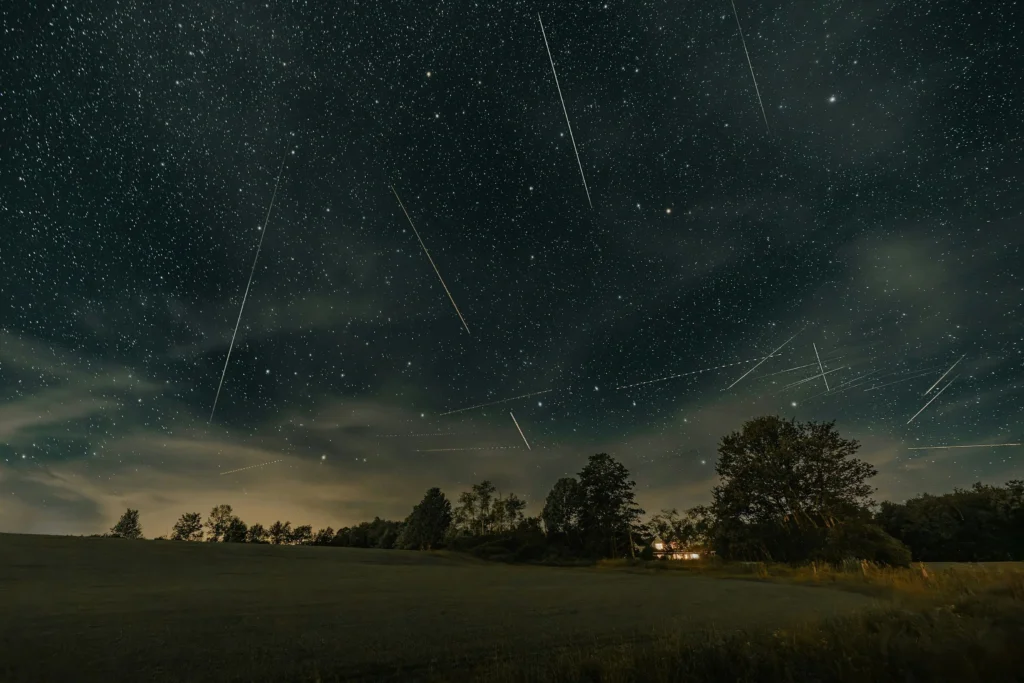Perseid Meteor Shower
Today marks the beginning of the Perseids, the most popular Perseid Meteor Shower of the year. With the peak night still a few weeks away, there’s plenty of time to plan a trip to see the show under dark skies. The Perseid meteor shower is one of the most anticipated celestial events, offering a spectacular display of “shooting stars” that can be enjoyed by everyone.

When and Where to Watch
The Perseid meteor shower runs from July 14 to September 1, 2024. The peak night will be from Sunday, August 11, through Monday, August 12. You can see Perseids on any clear night during this period, but the best chance to catch the most meteors will be on the peak night.
Peak Night Details:
| Date | Time (UTC) | Time (EDT) |
|---|---|---|
| August 12 | Around 04:00 UTC | 12 a.m. (midnight) EDT |
The peak will be broad, so you can start watching anytime after it gets dark on August 11. This year’s moon phase is ideal—a 43% lit waxing crescent will set before midnight, leaving the rest of the night free from moonlight, perfect for meteor watching.
Planning Your Trip
To fully enjoy the Perseids, plan a camping trip to a dark sky location. Book Monday off and spend a few hours between 11 p.m. and dawn watching the sky. Use a sunrise and sunset calculator to find the best times for your location. A camping trip not only offers a great opportunity to see the meteor shower but also to enjoy the tranquility and beauty of nature.
What to Expect
While some say you might see up to 150 meteors per hour, a more realistic expectation is around 50 “shooting stars” per hour during the peak. The Perseid meteor shower is known for its high frequency and bright meteors, making it one of the best meteor showers to watch.
Meteor Rates:
| Rate Type | Meteors per Hour |
|---|---|
| Ideal (Zenithal Hourly Rate) | 150 |
| Practical Expectation | 50 |
The Science Behind the Show
Meteors, or “shooting stars,” are tiny bits of rock or dust that burn up as they hit Earth’s atmosphere. The Perseid meteor shower is caused by debris from comet 109P/Swift-Tuttle, discovered in 1862 by Lewis Swift and Horace Tuttle. Each year, as Earth passes through the trail of debris left by the comet, these particles enter the atmosphere and create the bright streaks of light we see as meteors.
These meteors travel at about 37 miles per second and appear to come from the constellation Perseus, which you can find in the northeastern sky. The Perseids are known for their bright and fast meteors, often leaving long trails of light and color behind them.
Tips for Watching the Perseids
Here are some tips from NASA to help you enjoy the meteor shower:
- Get away from city lights: The darker the sky, the better your chances of seeing meteors. Light pollution from urban areas can significantly reduce the number of visible meteors.
- Find a clear view: Make sure you have an unobstructed view of the night sky. Open fields or high vantage points are ideal locations.
- Dress warmly: Nights can get cold, so bring warm clothes. Even in the summer, temperatures can drop significantly at night.
- Be patient: Watch for at least half an hour. A reclining chair or ground pad can make this more comfortable. The longer you watch, the more likely you are to see a good number of meteors.
- Avoid telescopes and binoculars: They narrow your field of view and make it harder to see meteors. Use your naked eye for the best experience.
- Limit white light: Avoid using your phone or other white lights as they can ruin your night vision. Use red light instead. Red lights help preserve your night vision, allowing you to see more meteors.
Conclusion
The Perseid Meteor Shower is an exciting celestial event you won’t want to miss. Whether you’re a seasoned stargazer or just looking for a fun night out, this is a great opportunity to enjoy the wonders of the night sky. So grab your popcorn, find a dark spot, and enjoy the best cosmic show of the year!